Blood in (and as) Art
One of the first known expressions of human creativity, the Lascaux cave paintings, were created with blood, a material that has remained significant...
Kaena Daeppen 10 June 2024
It has been a while since Game of Thrones ran its course. Are you planning to re-watch it anytime soon? Trying to escape our current bleak world, for the vivid and cruel one of Westeros? Have you ever wondered where the creators got their inspiration from? Of course, they started with the books, but how do you transpose a written description of a character into a fully-fleshed person with a specific hairstyle, clothes, and way of moving? One unavoidable answer is the imagination, but imagination must be fed, and there is no better food for it than art. Let us see together how art inspired Game of Thrones creators!
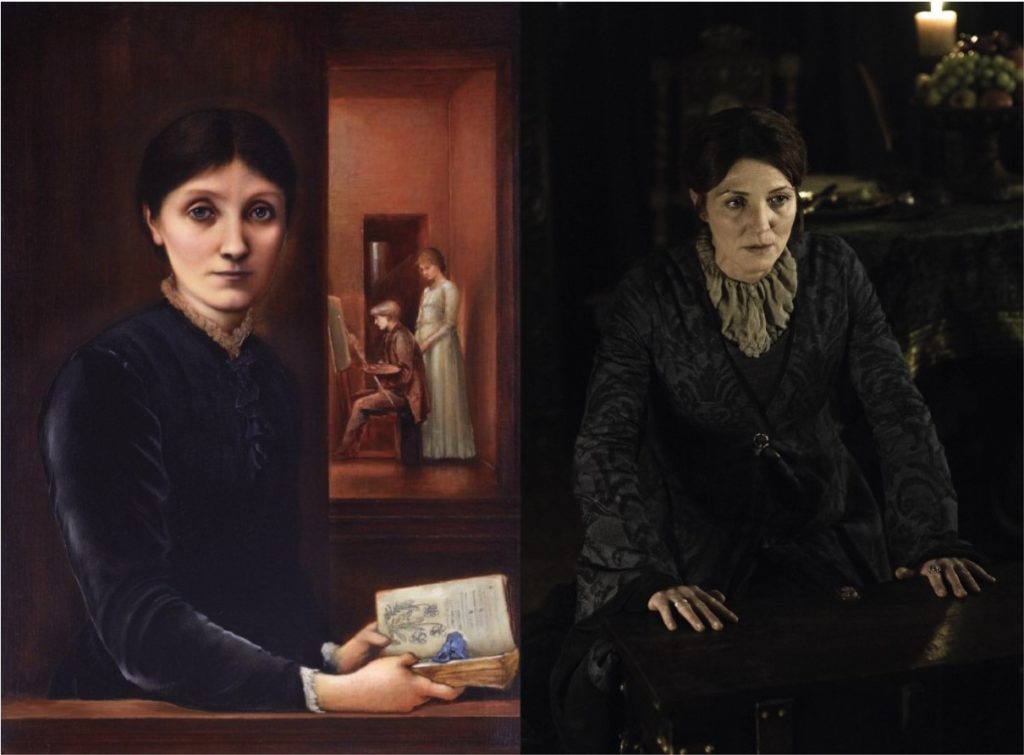
Georgiana Burne-Jones was the wife of the pre-Raphaelite painter, Edward Burne-Jones. At his request, she was the one to write his biography (featuring a very cute drawing of a wombat at the pyramids). Similarly to Catelyn Stark, she was her husband’s wife, but just like Catelyn, she was so much more. Georgiana was an artist herself, though not much of her work survived.
She was also very active in politics. In 1895, she won a seat on the parish council of her beloved Rottingdean. She supported the interests of the working class and women’s issues, taking positions in her electioneering materials that were radical for the wife of a baronet and simply baffling to the villagers of Rottingdean. Her day-to-day work in the parish focused on street lighting, fire brigades, and the provision of a village nurse for the community. Her politics became, if anything, more radical as she grew older.
Here, you can see her portrait by Edward, with their two children in the background. Georgiana’s face is solemn, serious, and focused but also ready for action. Dressed in a serious dark dress, with only a tiny decorative collar, she is all business. Not only her dress and hairstyle but also her attitude seem to be reflected in the character of Catelyn Stark.
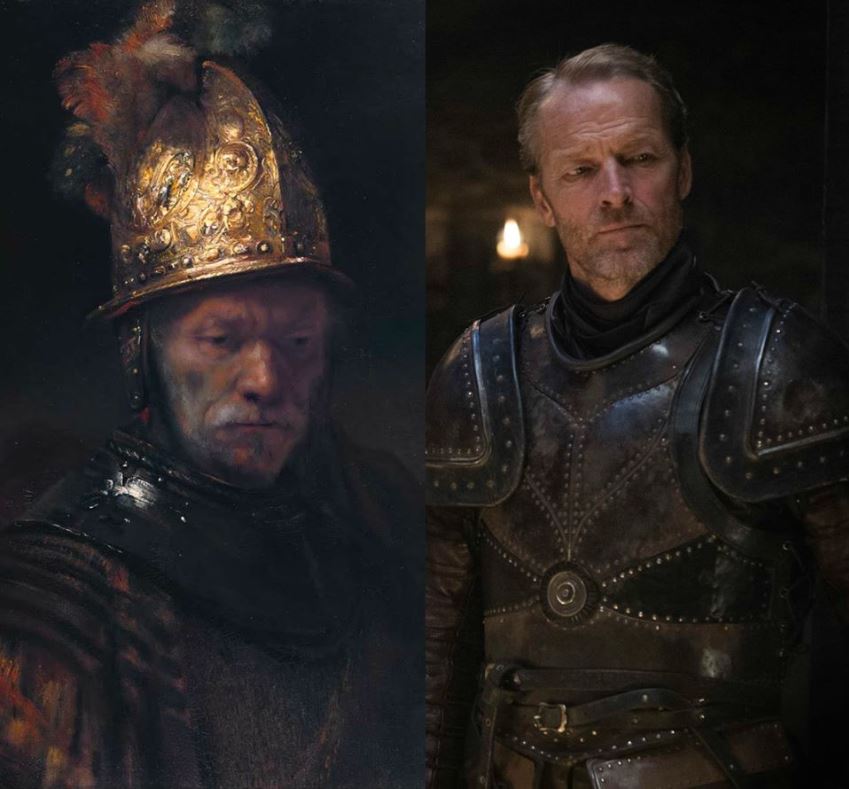
The similarity here is striking. Iain Glen as the GoT’s Ser Jorah Mormont bears an uncanny resemblance to the Man with the Golden Helmet. Just look at the nose, the set mouth, and eyes. Just as Ser Jorah, the painting has an interesting history.
For a long time, it was attributed to Rembrandt but, since the 1960s, there has been an increasing body of evidence that has led to the questioning of that attribution. During its restoration in the 1980s, a thorough technical examination followed. The helmet, with its thickly applied paint and sharply reflected light, particularly shows how Rembrandt’s expressive devices have been exaggerated. The dark, almost graphic presentation of the face is also not compatible with Rembrandt’s signature style. The technical and stylistic differences are revealed very clearly in a comparison with Rembrandt’s painting Man in Armour in Glasgow.
The Man with the Golden Helmet could be interpreted as representing Mars, the god of war, as a magnificent shining helmet had long been seen as his attribute. This theme was often taken up by painters in Rembrandt’s circle.
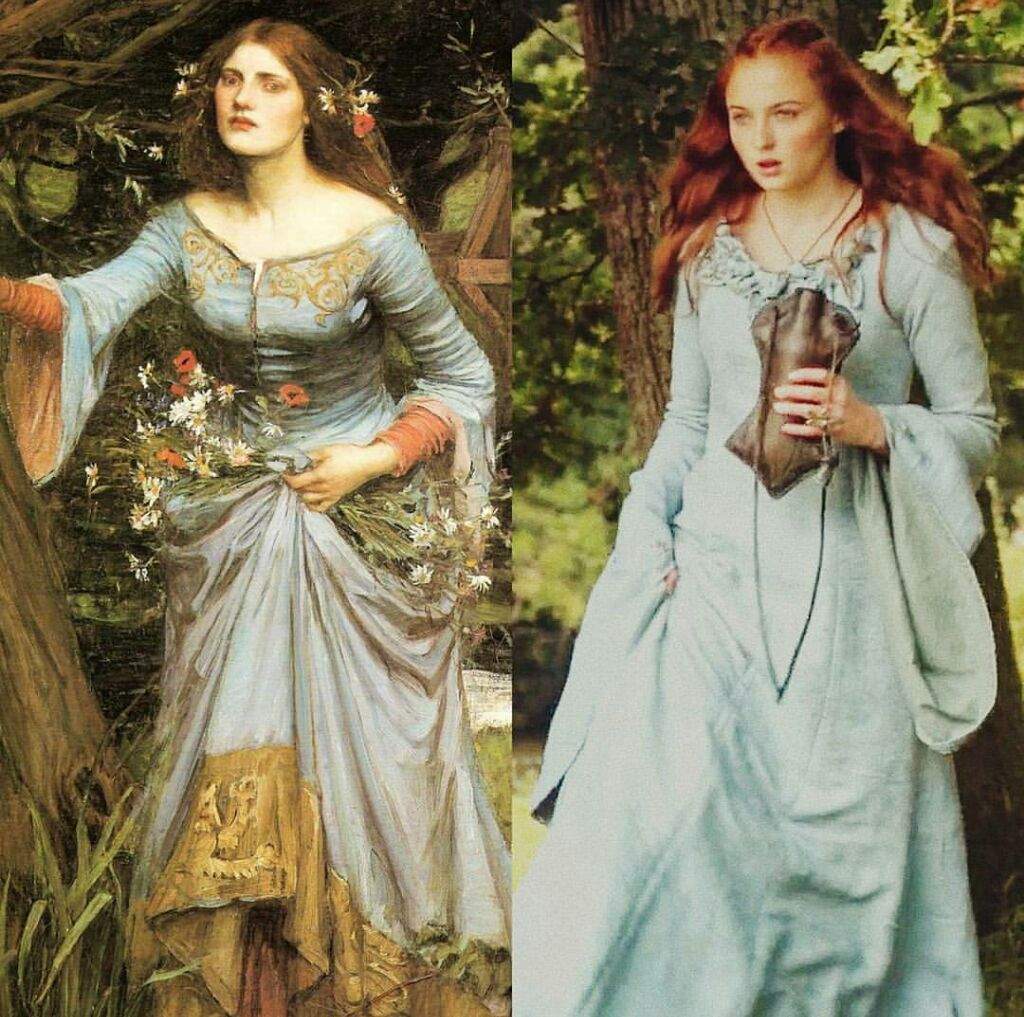
Maybe not as popular as the one by Sir John Everett Millais, the Ophelia by John William Waterhouse is certainly more dramatic. Her eyes looked beyond reality, long parted with anything resembling common sense. She runs through the wild meadows gathering flowers and looking for her lost love or maybe running away from the pain it is causing her. Her distress is obvious. Sansa Stark embodies the GoT’s damsel in distress, and her image is closely inspired by the pre-Raphaelite paintings.
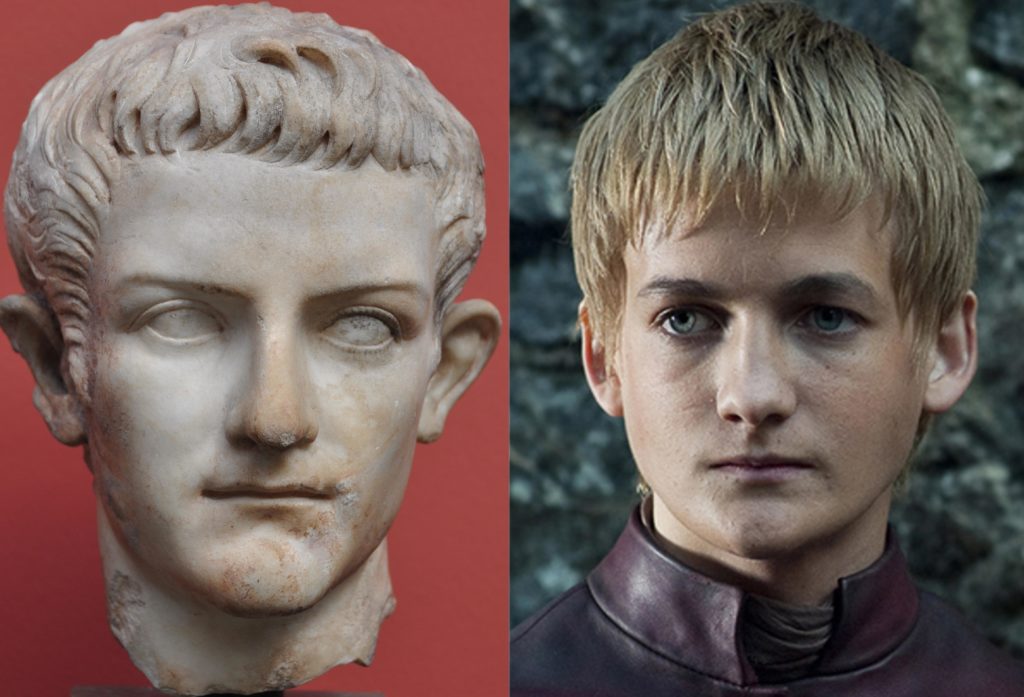
In this case, the similarity seems to go beyond pure looks. Caligula was the third Roman emperor, ruling from 37 to 41. Although he was born Gaius Caesar, after Julius Caesar, he acquired the nickname “Caligula” (meaning “little [soldier’s] boot,” the diminutive form of caliga) from his father’s soldiers during their campaign in Germania. There are few sources about the reign of Caligula, but he is described as a noble and moderate emperor during the first six months of his rule. After this, the focus is on his cruelty, sadism, extravagance, and sexual perversion, presenting him as an insane tyrant. These sources may be questionable, but during his brief reign, Caligula certainly worked to increase the unconstrained personal power of the emperor. Sounds vaguely familiar…
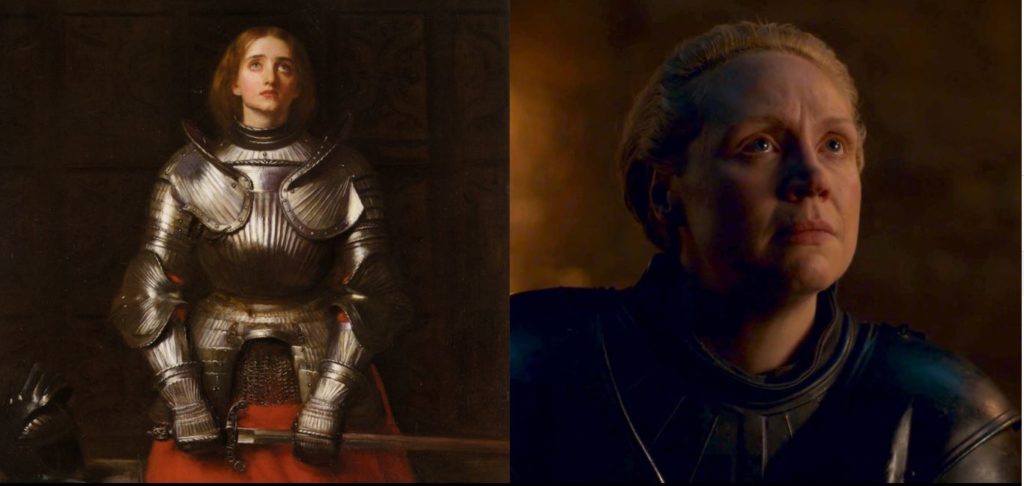
Joan of Arc is a painting created by John Everett Millais in 1865. She is kneeling in prayer but holding a sword in both hands. With her head uncovered, and eyes turned upwards, as to heaven, she has a forlorn look on her face. Millais has captured in this portrait the historical moment when Joan of Arc is encouraged by Saints Michael, Margaret, and Catherine to lead the battle against the English. As we all know, it didn’t end well for her, despite her trusting look towards the heavens. When this portrait was first shown at the Royal Academy in London, a critic from the Art Journal drew attention to the “faithful realization of steel armor.” But the painting is so much more. A woman in man’s armor, but at the same time sporting a red skirt. She tries to be both in a world that demands a clear separation.
Brienne of Tarth is the woman warrior of GoT. She is at the same time very similar to Joan of Arc and very different from her. Brienne focuses on the warrior side of her nature, her feelings a risk to herself and those she cares about. As Joan is trusting, Brienne is strong but lacks hope and she knows honor, justice, suffering, and despair. Both of them have to fight with being ridiculed and not taken seriously.
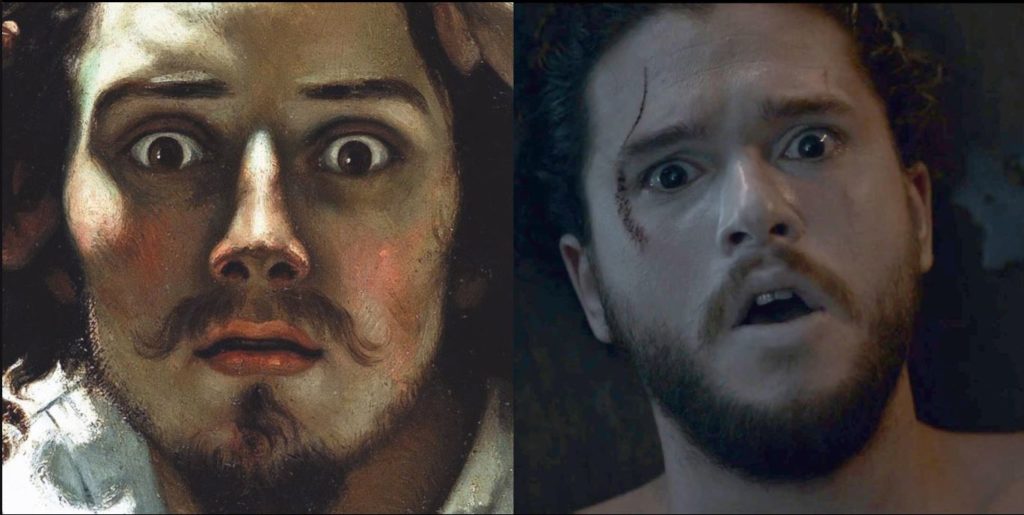
Courbet’s Self-Portrait as the Desperate Man is one of his many self-portraits. The man really liked looking at himself, there is no denying that. Here, Courbet presents himself frontally in a tight, claustrophobic, horizontal frame. His expression seems to be one of both fear and psychosis. The painting remained in his studio until his death. It must have been important to him if he decided not to part with it. Maybe it reminded him of his origins, of the time when he was a young artist, still building his reputation, struggling to make ends meet.
Jon Snow, on the other hand, as we know, knows nothing. Yet, as he comes back to life, his face echoes Courbet’s desperation. As if he knows over and over again, he will lose everything that is dear to him.
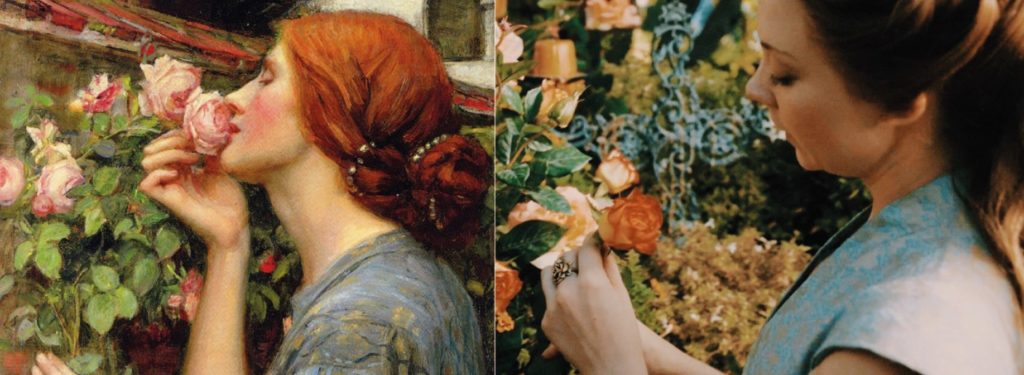
Clearly, the creators of GoT had a book of John William Waterhouse’s works at hand. Here, we can see Margaery Tyrell copying a pose of Waterhouse’s model from The Soul of the Rose. Waterhouse’s title is loosely derived from Chaucer’s dream poem, Romaunt of the Rose, itself adapted from the 13th-century French romance: Roman de la Rose by Guillaume de Lorris. The narrator embarks on a pilgrimage with the god of love, who leads him to a rose symbolizing perfect love. The Soul of the Rose was painted when Waterhouse was in his creative maturity; an artist established with patrons and public alike, who pursued his unique vision whilst adapting to modern style.
The Soul of the Rose was sold in 2007 for 1,140,000 GBP at Christie’s. If it ever comes to the market again, it will surely go for more, so start saving!
Article inspired by Game of Thrones Georgia.
DailyArt Magazine needs your support. Every contribution, however big or small, is very valuable for our future. Thanks to it, we will be able to sustain and grow the Magazine. Thank you for your help!